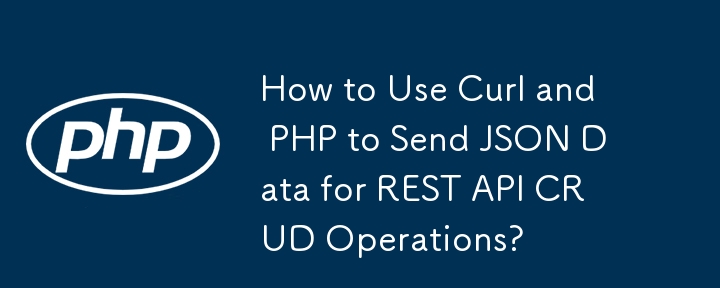Maison >développement back-end >tutoriel php >Comment utiliser Curl et PHP pour envoyer des données JSON pour les opérations CRUD de l'API REST ?
Comment utiliser Curl et PHP pour envoyer des données JSON pour les opérations CRUD de l'API REST ?
- DDDoriginal
- 2024-11-23 02:28:10980parcourir

Comment transmettre des données JSON avec Curl et PHP pour PUT, POST, GET et DELETE
Utiliser Curl et PHP pour les opérations CRUD sur Les API REST constituent une approche pratique. Alors que la ligne de commande offre des méthodes simples pour transmettre des données JSON, PHP nécessite une implémentation personnalisée.
Implémentation PHP Curl pour PUT :
<?php
$data = array('username' => 'dog', 'password' => 'tall');
$data_json = json_encode($data);
$ch = curl_init();
curl_setopt($ch, CURLOPT_URL, $url);
curl_setopt($ch, CURLOPT_HTTPHEADER, array('Content-Type: application/json', 'Content-Length: ' . strlen($data_json)));
curl_setopt($ch, CURLOPT_CUSTOMREQUEST, 'PUT');
curl_setopt($ch, CURLOPT_POSTFIELDS, $data_json);
curl_setopt($ch, CURLOPT_RETURNTRANSFER, true);
$response = curl_exec($ch);
curl_close($ch);
?>
PHP Curl Implémentation pour POST :
<?php
$ch = curl_init();
curl_setopt($ch, CURLOPT_URL, $url);
curl_setopt($ch, CURLOPT_HTTPHEADER, array('Content-Type: application/json'));
curl_setopt($ch, CURLOPT_POST, 1);
curl_setopt($ch, CURLOPT_POSTFIELDS, $data_json);
curl_setopt($ch, CURLOPT_RETURNTRANSFER, true);
$response = curl_exec($ch);
curl_close($ch);
?>
Implémentation PHP Curl pour GET (Alternative Approche) :
<?php
$query_string = http_build_query($data);
$url = $url . '?' . $query_string;
$ch = curl_init();
curl_setopt($ch, CURLOPT_URL, $url);
curl_setopt($ch, CURLOPT_HTTPHEADER, array('Content-Type: application/json'));
curl_setopt($ch, CURLOPT_RETURNTRANSFER, true);
$response = curl_exec($ch);
curl_close($ch);
?>
Implémentation PHP Curl pour DELETE :
<?php $ch = curl_init(); curl_setopt($ch, CURLOPT_URL, $url); curl_setopt($ch, CURLOPT_CUSTOMREQUEST, "DELETE"); curl_setopt($ch, CURLOPT_POSTFIELDS, $data_json); curl_setopt($ch, CURLOPT_RETURNTRANSFER, true); $response = curl_exec($ch); curl_close($ch); ?>
Ce qui précède est le contenu détaillé de. pour plus d'informations, suivez d'autres articles connexes sur le site Web de PHP en chinois!
Articles Liés
Voir plus- Comment utiliser cURL pour implémenter les requêtes Get et Post en PHP
- Comment utiliser cURL pour implémenter les requêtes Get et Post en PHP
- Comment utiliser cURL pour implémenter les requêtes Get et Post en PHP
- Comment utiliser cURL pour implémenter les requêtes Get et Post en PHP
- Tous les symboles d'expression dans les expressions régulières (résumé)

